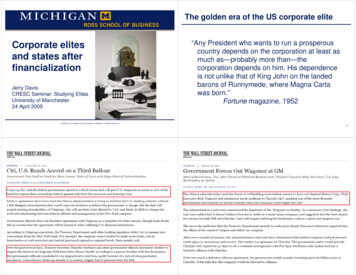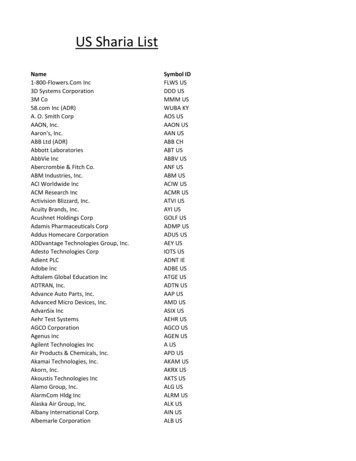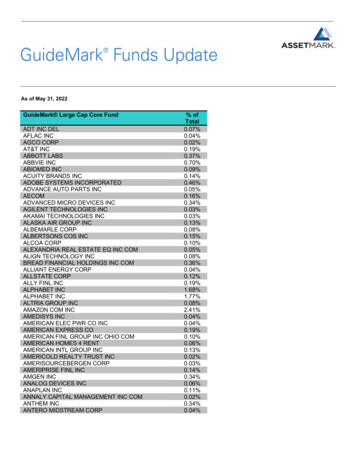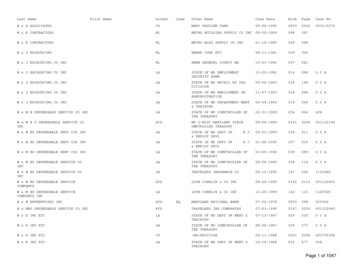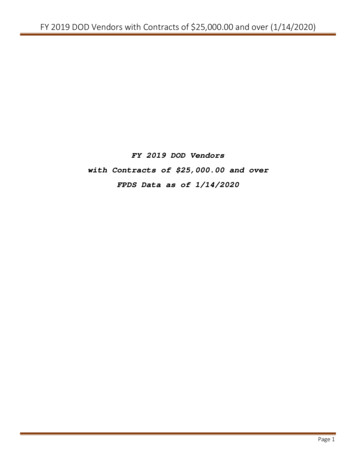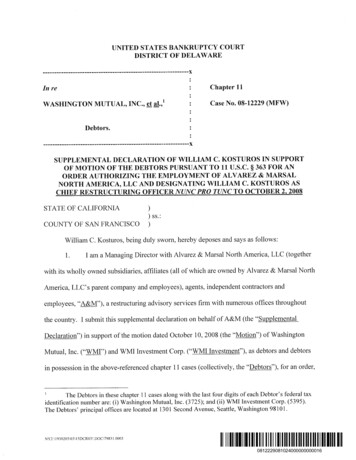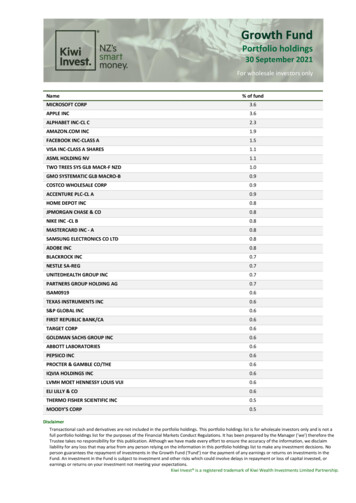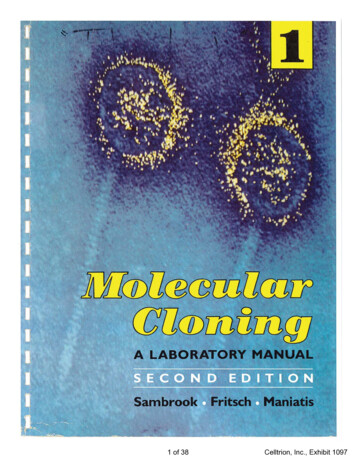
Transcription
1 of 38Celltrion, Inc., Exhibit 1097
MolecularCloning2 of 38Celltrion, Inc., Exhibit 1097
Associate AuthorNina IrwinManaging EditorNancy fordEditorChris NolanAssociate EditorRlustratorMichele FergusonMichael Ockler3 of 38Celltrion, Inc., Exhibit 1097
oleeularCloningA LABORATORY MANUALSECOND EDITIONJ.SambrookUNIVERSITY OF TEXAS SOUTHWESTERN MEDICAL CENTERE.F. FritschGENETICS INSTITUTET. ManiatisHARVARD UNIVERSITY4 of 38Celltrion, Inc., Exhibit 1097
MolecularCloningA LABORATORY MANUALSECOND EDITIONAll rights rl st rn d1989 b) ('old Spring Harbor Laboratory PressPrintc d in the United States of America 98 7654Bovl andro1 1 r·design by Emily HarsteCo1 er: The electron micrograph of bacteriophage ;. particless tained with uranyl acetate was digitized and assigned false colorby comput('r. tThomas R. Broker, Louise T. Chow, and J ames 1.Garreh;)Catalog111g111Pttbl1cations dataSambrook. JosephMolecular cloning . a labora tory manual I E.F.Fritsch. T Maniatis-2nd ed.cm.p.Bibliography· pIncludes indexISBN 0-87969-309-6l Molecular cloning-baboratory manuals. 2. Eukaryolic cells-Laboratory manuals. l. Fritsch. Edward F. II. Maniatis. ThomasIll TitleQH442.2 M26 198787-35464574 .87'3224-dcl9Rescnrchers using the procedures of this manual do so at their own risk. Cold Spring Ha rborLaboratory makes no representations or warranties with respect to the material set forth inthis manual and ha1 no liabilil.y in connection with the use of these materials.Authoriza1ion to photocopy items for internal or personal use, or the internal or personal use ofspecific clients. 1s granted by Cold Spring Harbor Laboratory Press for li braries a nd otherusers registered with the Copyright Clearance Center CCC I Transactional Reporting Service.provided that the base fee of 0.10 per page is paid directly to CCC, 21 Congress St. Salem MA0 1970 [0-87969-309-6/ 89 00 -.- 0. lOJ This consent docs not extend to other kindb of copying.such as copying for general distribution. for advertising or promotional purposes. for creatingne'' collectwe works. or for resale.All ('old Spring Harbor Laboratory Press publications may bt ordered d1rcc.'lly from ColdSpring H:irbor Laborator) Press. JO Skyline Drh e. Plainview New York 11803. Phone:1-800-843-438b In New York 15161 367-8423. FAX: 15161 367-0432.5 of 38Celltrion, Inc., Exhibit 1097
Pre-rac e to First EditionThis manual began as a collection of laboratory protocols that were usedduring the 1980 Cold Spring Harbor course on the Molecular Cloning ofEukaryotic Genes. These procedures had been in use in our laboratories atthat time but were scattered throughout the notebooks of many differentpeople. In 1981 we decided to produce a more complete and up-to-datemanual not only for use in the next Cold Spring Harbor course, but also foreventual publication. Out of the many permutations of the methods beingused, we assembled a set of "consensus protocols," which were photocopiedand widely distributed to many laboratories even as the 1981 course wasunderway. Then in the winter of 1981-1982, the manual was substantiallyrewritten, and new or revised protocols and figures, as well as entirely newchapters, were added.Even since this last rewriting, however, the field has progressed: Newmethods are constantly being invented and existing techniqu es are altered inresponse to changing needs. Although we have included in this manual onlythose protocols that have been thoroughly tested and used successfully in ourlaboratories, we make no claim that they are inviolable or perfect. We wouldwelcome suggestions for improvements, and we would be grateful to be toldabout any new procedures that are devised.The evolution of protocols poses the difficult problem of attribution. Wehave tried to give credit at appropriate places in the text to the people whooriginally developed the procedures presented here, but in many casestracing a particular method to its undisputed roots has proved to be impossible. We therefore wish to apologize-and to express gratitude-to those wehave been unable to acknowledge for an idea, procedure, or recipe. Our majorfunction has been to compile, to ver:ify, and, we hope, to clarify; less frequently we have introduced modifications, and only in rare instances have wedevised new protocols. In large part, then, the manual is based on proceduresdeveloped by others, and it is to them that any credit belongs.Because the manual was originally written to serve as a guide to those whohad little experience in molecular cloning, it contains much basic material.However, the current version also deals in detail with almost every laboratory task currently used in molecular cloning. We therefore hope thatnewcomers to cloning and veterans alike will find material of value in thisbook.Although molecular cloning seems straightforward on paper, it is moredifficult to put into practice. Most protocols involve a large number of6 of 38Celltrion, Inc., Exhibit 1097
individual steps and a problem with any one of them can lead the experimenter into difficulty. It is a good idea to verify the products of each step and toinclude controls to check the efficiency of each reaction. To deal with theseproblems, a well-founded understanding of the principles underlying eachprocedure is essential. We have therefore provided background informationand references that may be useful should trouble occur.This manual could not have been written without the help and advice ofmembers of our laboratories and contributions from many others. Wetherefore wish to thank Joan Brooks, John Fiddes, Mary-Jane Gething, TomGingeras, David Goldberg, Steve Hughes, David Ish-Horowicz, Mike Mathews,Patty Reichel, J oe Sorge, Jim Stringer, Richard Treisman, and Nigel Whittle.We wish particularly to thank Arg Efstratiadis for his helpful discussions andcriticisms of Chapter 7; Brian Seed for permission to include a description ofhis unpublished procedure for screening libraries by recombination (Chapter10) and many other useful suggestions; Doug Hanahan for advice on transformation (Chapter 8); Bryan Roberts for suggestions on methods of hybridselection and cDNA cloning; Doug Melton for providing a protocol for injection of Xenopus oocytes; Ronni Greene for suggesting improvements to manyprotocols; Nina Irwin for providing a critical anthology of methods availablefor expressing eukaryotic proteins in bacteria (Chapter 12); Rich Roberts forsupplying the computer analysis of the sequence of pBR322; Barbara Bachmann and Ahmad Bukhari for reviewing and correcting the list of E. colistrains; and Tom Broker, Louise Chow, Jeff Engler, and Jim Garrels forproducing the elegant photographs used for the front and back covers.We also thank all those who participated in the Cold Spring HarborMolecular Cloning courses of 1980 and 1981. They were an excellent group ofstudents, who struggled through the first two drafts of the manual and mademany useful suggestions. We also thank Nancy Hopkins, who helped us toteach the course the first year and convinced us that producing a manualwould be a worthwhile task. In 1981 Doug Engel helped teach the course andsuggested many improvements to the manual. Contributing to the success ofboth courses were the efforts of the teaching assistants, who were CatherineO'Connell and Helen Doris Keller in the summer of 1980 and Susan VandeWoude, Paul Bates, and Michael Weiss in 1981.We wish to thank Patti Barkley and Marilyn Goodwin for their cheerfulness and forbearance during the typing of successive revisions of the manuscript. Our artists, Fran Cefalu and Mike Ockler, worked with greatdedication and perseverance to produce the drawings for the manual. JoanEbert kept track of the many references added to and deleted from the textand assembled the reference list. We are also grateful to Nancy Ford,Director of Publications, Cold Spring Harbor Laborato.ry, for her encouragement and support. Finally, without the patience, skill, and diplomacy ofDoug Owen, who prepared the manuscript for the printer and helped us inmany other ways, this book would not exist.Tom ManiatisEd FritschJoe SambrookTI Preface to First Edition7 of 38Celltrion, Inc., Exhibit 1097
Pre aee to Second EditionSince the publication of the first edition of this Laboratory Manual in 1982,there has been a vast increase both in the number of people who usemolecular cloning and in the range and power of the techniques used tohandle recombinant DNA. This remarkable proliferation of cloning methodsis reflected in the number of gene sequences in the GenBank DNA sequencedata base. In 1982 there were fewer than 350 gene sequences on file, but inless than four years this number grew to almost 5000. Today over 15,000sequences are listed. These figures, impressive as they are, do not do justiceto the increased sophistication with which cloned genes are now analyzed. In1982, respectable journals would still accept manuscripts containing littlemore than the partial sequence of a cDNA clone; today, the publication of acomplete sequence is taken for granted, and papers describing the initialcloning of a cDNA will often also contain elegant accounts of the expression ofthe gene product in prokaryotic or eukaryotic hosts. In most cases, this firstpaper is rapidly followed by others that use site-directed mutagenesis toexplore the relationship between the structure and function of the relevantprotein. The cloning and analysis of elements that regulate the expression ofeukaryotic genes has moved at a similar, exciting pace.This increase in the range and speed of molecular cloning is reflected in thetripling of size of this manual and its consequent division into three volumes.Techniques that were mentioned only in passing in the first edition, such asmutagenesis, expression of cloned genes in mammalian cells, and dideoxymediated sequencing, are now described in depth; new sections have beenadded that deal with recently invented techniques, such as amplification ofDNA by the polymerase chain reaction; and we have included modernvariations and embellishments of many of the basic methods that were themainstay of the first edition. We hope that any inconvenience caused by theexpansion in size of the manual will be compensated by an increase in therichness of its content. We hope that this second edition will be a resource forthe experienced cloner, a starting point for the student, and a guidebook forthe next generation of investigators in molecular cloning.The burgeoning of molecular cloning has also led to its commercialization,and we are now able to purchase a wide variety of high quality andreasonably priced reagents and enzymes. Although this is a very positivedevelopment, it has had a few unfortunate side effects. One is the proliferation of preassembled kits to carry out particular cloning tasks. Althoughthese kits reduce the possibility of trivial errors, they also tend to discourageexperimenters from thinking about what they are doing. It becomes all too8 of 38Celltrion, Inc., Exhibit 1097
easy to follow blindly instructions to add 2 µ.l of solution A without knowingwhat the particular reagent is, why it is necessary, or why it is added at aparticular point in the protocol. Kits therefore reward the scientificallyilliterate and inhibit the development of improvements . In an attempt tocounteract this trend, we have greatly increased the amount of backgroundmaterial at the beginning of each chapter of the manual and we haveprovided full references. Users of the manual who read this material shouldhave no problem understanding either the general design or the specificdetails of the experimental protocols. We also strongly recommend readingthe relevant protocols in their entirety before commencing work. This allowsreagents to be prepared ahead of time and permits the investigator to carryout the protocol efficiently.This manual could not have been produced without the help and encouragement of a large number of people. We are extremely grateful to colleaguesfrom the University of Texas Southwestern Medical Center at Dallas, fromGenetics Institute, from Harvard University, and from many other institutions who have read individual chapters, have submitted protocols, and havemade many invaluable suggestions that have immeasurably improved themanual. We have listed all these individuals with their affiliations in aspecial section at the end of this preface.We owe a special debt of thanks to Rick Myers and Alison Cowie of theUniversity of California at San Francisco, who read all of the chapters indraft, eliminated many embarrassing errors, and made many valuable suggestions for improvements ; to Winship Herr of Cold Spring Harbor Laboratory and Mary-Jane Gething of Southwestern Medical Center, who draftedthe chapters on DNA sequencing and expression of cloned genes in mammalian cells, respectively; and to Judy Campbell, who contributed significantly to the preparation of the chapter on enzymes. We are also grateful toMike Ockler, who provided all of the conceptual illustrations in this edition,and to Carolyn Doyle, who assembled the index.Nina Irwin has played a special role in the writing of this manual. Amongher many contributions are the E. coli strain list and the maps of the manystrains of bacteriophage ,\, plasmids, cosmids, and bacteriophage M13 used inthis manual. These maps are based on many months of painstaking work toreconstruct and verify the genealogy of these host and vector strains. . Inaddition, Nina also drafted the chapter on expression of cloned genes inprokaryotic hosts, read and reviewed all of the chapters in manuscript andgalleys, and searched the scientific literature with great intelligence and skillto validate many of the facts that appear.We also wish to thank Jim Watson for his continued interest in thismanual. The support he has provided made this edition possible.Finally, we would like to express our deep appreciation of the work of oureditor Nancy Ford. For over two years, she has worked untiringly to bringorder and sense to the entire project and to improve and clarify our writing.Nancy and her assistant Michele Ferguson have both served as a source ofencouragemen t, sympathy, and friendship. We are greatly in their debt.J. SambrookE.F. FritschT. Maniatisviil Preface to Second Edition9 of 38Celltrion, Inc., Exhibit 1097
Ed Alderman, Genetics InstitutePatricia Ashley, University of Texas Southwestern Medical CenterMargaret Baron, Harvard UniversityFrank Baas, Harvard UniversityPhil Bird, University of Texas Southwestern Medical CenterTom Bittick, University of Texas Southwestern Medical GenterColleen Brewer, University of Texas Southwestern Medical GenterGene Brown, Genetics InstituteH. Franklin Bunn, Harvard Medical SchoolSteve Clark, Genetics InstitutePreston Dunnmon, University of Texas Southwestern Medical CenterAnne Ephrussi, Harvard UniversityHenry Erlich, Perkin Elmer CetusChen-Ming Fan, Harvard UniversityKen Ferguson, Cold Spring Harbor LaboratoryBill Garrard, University of Texas Southwestern Medical CenterBob Gerard, University of Texas Southwestern Medical CenterGary Gilliland, Harvard Medical SchoolDoug Hanahan, University of California, San FranciscoEd Harlow, Cold Spring Harbor LaboratoryJean Henneberry, University of Texas Southwestern Medical CenterBill Huse, StratageneDavid Ish-Horowicz, Imperial Cancer Research FundDavid Israel, Genetics InstituteRandy Kaufman, Genetics InstituteAndrew Keller, Harvard UniversityJohn Knopf, Genetics InstituteSteve Lacey, University of Texas Southwestern Medical CenterRay MacDonald, University of Texas Southwestern Medical CenterEd Madison, University of Texas Southwestern Medical CenterMike Mathews, Cold Spring Harbor LaboratoryMichael McClelland, University of ChicagoJohn McCoy, Genetics InstituteSteve McKnight, Carnegie Institution of Washington oug Melton, Harvard UniversityAlan Michelson, Harvard UniversityGeorge Morris, Genetics InstituteMichael Nelson, University of ChicagoRobin Reed, Harvard UniversityRich Roberts, Cold Spring Harbor LaboratoryLaura Roman, University of Texas Southwestern Medical CenterSusan Rosenberg, University of UtahDavid Russell, University of Texas Southwestern Medical CenterBrian Seed, Harvard Medical SchoolConrad Seghers, University of Texas Southwestern Medical CenterMark Segal, University of Texas Southwestern Medical CenterChuck Shoemaker, Harvard School of Public HealthHuda Shubeita, University of Texas Southwestern Medical CenterHarinder Singh, University of ChicagoBeth Smith, Information Center, Genetics InstituteJoe Sorge, StratageneLisa Sultzman, Genetics InstituteGalvin Swifr, University of Texas Southwestern Medical CenterPatty Temple, Genetics InstituteJeff Vieira, Rutgers UniversityGeoff Wahl, Salk InstituteSteve Wasserman, University of Texas Southwestern Medical CenterGordon Wong, Genetics InstituteRick Young, Massachusetts Institute of TechnologyJian-Hua Zhang, University of Texas Southwestern Medical CenterMark Zoller, Genentech10 of 38Celltrion, Inc., Exhibit 1097
ContentstBOOK 11Plasmid YeetorsEssential Features of Plasmids 1.3Replication and Incompatibility 1.3Mobilization 1.5Selectable Markers 1.5Plasmid Vectors 1.7DEVELOPMENT OF PLASMID CLONING VECTORS 1.7Plasmid Vectors That Permit Histochemical Identification of RecombinantClones 1.8Plasmid Vectors Carrying Origins of Replication Derived from Single-strandedBacteriophages 1.9Plasmid Vectors Carrying Bacteriophage Promoters 1.9Plasmid Vectors That Allow Direct Selection of Recombinant Clones 1.9Plasmid Expression Vectors 1.10COMMONLY USED PLASMID VECTORS 1.11pBR322 1.12pUC18, pUC19 1.13pUC118, pUC119 1.14pSP64, pSP65, pGEM-3, pGEM-3Z, pGEM-3Zf{-), pGEM-4, pGEM-4Z 1.151TAN13 1.191.20BLUESCRIPT M13 , M13 -Extraction and Purification of Plasmid DNA 1.21Growth of the Bacterial Culture 1.21Harvesting and Lysis of the Bacteria 1.22Purification of Plasmid DNA 1.23SMALL-SCALE PREPARATIONS OF PLASMID DNA 1.25Harvesting and Lysis of Bacteria 1.25xi11 of 38Celltrion, Inc., Exhibit 1097
HARVESTING 1.25LYSIS BY ALKALI 1.25LYSIS BY BOILING 1.29Solving Problems That Arise with Minipreparations of Plasmid DNA 1.31Rapid Disruption of Bacterial Colonies to Test the Size of Plasmids 1.32LARGE-SCALE PREPARATIONS OF PLASMID DNA 1.33Amplification of Plasmids in Rich Medium 1.33Harvesting and Lysis of Bacteria 1.34HARVESTING 1.34LYSIS BY BOILING 1.34LYSIS BY SODIUM DODECYL SULFATE 1.36LYSIS BY ALKALI 1.38PURIFICATIO N OF PLASMID DNA 1.40Purification of Plasmid DNA by Precipitation with Polyethylene Glycol 1.40Purification of Closed Circular DNA by Equilibrium Centrifugation in CsClEthidium Bromide Gradients 1.42CONTINUOUS GRADIENTS 1.42DISCONTINUOUS GRADIENTS 1.44Removal of Ethidium Bromide from DNAs Purified by EquilibriumCentrifugation in CsCl-Ethidium Bromide Gradients 1.46METHOD 1: EXTRACTION WITH ORGANIC SOLVENTS 1.46METHOD 2: ION-EXCHANGE CHROMATOGRAPHY 1.47Decontamination of Ethidium Bromide Solutions 1.49DECONTAMINATION OF CONCENTRATED SOLUTIONS OF ETHIDIUM BROMIDE 1.49DECONTAMINATION OF DILUTE SOLUTIONS OF ETHIDIUM BROMIDE 1.50Removal of RNA from Preparations of Plasmid DNA 1.51CENTRIFUGATION THROUGH 1 M NaCl 1.51CHROMATOGRAPHY THROUGH BIO-GEL A-150m OR SEPHAROSE CL-4B 1.52Strategies for Cuming in Plasmid Vectors 1.53STRATEGIES FOR LIGATION 1.53The Nature of the Ends of the Foreign DNA Fragment 1.53FRAGMENTS CARRYING NONCOMPLEMENTARY PROTRUDING TERMINI 1.53FRAGMENTS CARRYING IDENTICAL TERMIN1 (BLUNT-ENDED OR PROTRUDING) 1.56FRAGMENTS CARRYING BLUNT ENDS l.56The Nature of the Restriction Sites in the Plasmid Vector and the ForeignDNA 1.59DEPHOSPHORYLATION OF LINEARIZED PLASMID DNA 1.60Test Ligations and Transformations 1.62LIGATION REACTIONS 1.63Setting Up Ligation Reactions Between Foreign DNA and Plasmid Vectors 1.63Ligation of Cohesive Termini 1.68Ligation of Blunt-ended DNA 1. 70CONDENSING AGENTS 1.70Rapid Cloning in Plasmid Vectors1. 72Preparation and Transformat ion of Competent E. coli 1.74Transformation of E. coli by High-voltage Electroporation(Electrotransformation) 1. 75Protocol I: Preparation of Fresh or Frozen Competent E. coli 1. 76Protocol II: Fresh Competent E. coli Prepared Using Calcium Chloride 1.82xU Contents12 of 38Celltrion, Inc., Exhibit 1097
Identification of Bacterial Colonies That Contain RecombinantPlasmids 1.85RESTRICTION ANALYSIS OF SMALL-SCALE PREPARATIONS OF PLASMIDDNA 1.85a-COMPLEMENTATION 1.85Testing Bacteria for a-Complementation 1.86INSERTIONAL INACTNATION 1.87SCREENING BY HYBRIDIZATION 1.90Transferring Small Numbers of Colonies to Nitrocellulose FiltersReplicating Colonies onto Nitrocellulose Filters 1.931.92METHOD l 1.93METHOD 2 1.96Lysis of Colonies and Binding of DNA to Nitrocellulose Filters 1.98METHOD 1 1.98METHOD 2 1.100Hybridization to Nitrocellulose Filters Containing Replicas of BacterialColonies 1.101References 1.1052Bacteriophage A YectorsMolecular Biology of Bacteriophage A 2.3THE LYTIC CYCLE 2.3Adsorption 2.3Immediate Early Transcription 2.5Delayed Early Transcription 2.5DNA Replication 2.5Late Transcription 2.5Assembly 2. 7Lysis 2.8LYSOGENY 2.8Bacteriophage A Vectors 2.9CONSTRUCTION OF BACTERIOPHAGE A VECTORS: A BRIEF HISTORY 2.9CHOOSING THE APPROPRIATE BACTERIOPHAGE A VECTOR 2.11MAPS OF BACTERIOPHAGE A VECTORS 2.15A'2.17CHARONCHARONCHARONCHARON4A 2.1821A 2.2032 2.2233 2.24Contents13 of 38:d.ilCelltrion, Inc., Exhibit 1097
CHARON 34 2.26CHARON 35 2.28CHARON 40 2.30EMBL3A 2.32,\2001 2.34ADASH 2.36AFIX 2.38AgtlO 2.40Agtll 2.42Agtl8 2.44Agt20 2.46Agt22 2.48AORF8 2.50AZAP/R 2.52CHOOSING A BACTERIAL HOST FOR BACTERIOPHAGE A VECTORS 2.55Restriction and Modification 2.55Amber Suppressors 2.55Recombination Systems 2.55Bacteriophage A Growth, Purification, and DNA Extraction 2.60PLAQUE PURIFICATION OF BACTERIOPHAGE A 2.60Preparation of Plating Bacteria 2.60Plating Bacteriophage A 2.61Picking Bacteriophage A Plaques 2.63PREPARING STOCKS OF BACTERIOPHAGE A FROM SINGLE PLAQUES 2.64Plate Lysate Stocks 2.64PREPARATION OF PLATE LYSATE STOCKS: PROTOCOL I 2.65PREPARATION OF PLATE LYSATE STOCKS: PROTOCOL II 2.66Small-scale Liquid Cultures2.67Long-term Storage of Bacteriophage A Stocks 2.68LARGE-SCALE PREPARATION OF BACTERIOPHAGE A 2.69Infection at Low Multiplicity 2. 70Infection at High Multiplicity 2. 72PURIFICATION OF BACTERIOPHAGE A 2. 73Standard Method for Purification of Bacteriophage A 2. 73Alternative Methods for Purification of Bacteriophage A 2. 77PELLETING BACTERIOPHAGE PARTICLES 2.77GLYCEROL STEP GRADIENT 2.78EQUILIBRIUM CENTRIFUGATION IN CESIUM CHLORIDE 2.79EXTRACTION OF BACTERIOPHAGE A DNA 2.80Cloning in Bacteriophage A 2.82PREPARATION OF VECTOR DNA 2.82Digestion of Bacteriophage A DNA with Restriction Enzymes 2.83Purification of Bacteriophage A Arms 2.85CENTRIFUGATION THROUGH SUCROSE DENSITY GRADIENTS 2.85CENTRIFUGATION THROUGH SODIUM CHLORIDE GRADIENTS 2.88Preparation of Vectors Treated with Alkaline Phosphatase 2.90Digestion of Bacteriophage A Vectors with Two Restriction Enzymes 2.92Ligation of Bacteriophage A Arms to Fragments of Foreign DNA 2.94xiv Contents14 of 38Celltrion, Inc., Exhibit 1097
PACKAGING OF BACTERIOPHAGE A DNA IN VITRO 2.95Maintenance and Testing of Lysogens of Bacteriophage A 2.96Preparation of Packaging Extracts and Packaging of Bacteriophage A DNA InVitro 2.98PROTOCOLPROTOCOLPROTOCOLPROTOCOLI: PREPARATION OF PACKAGING EXTRACTS FROM TWO LYSOGENS 2.100I: PACKAGING IN VITRO USING TWO EXTRACTS 2.104II: PREPARATION OF PACKAGING EXTRACTS FROM ONE LYSOGEN 2.105II: PACKAGING IN VITRO USING ONE EXTRACT 2.107Identification and Analysis of Recombinants 2.108IN SITU HYBRIDIZATION OF BACTERIOPHAGE A PLAQUES 2.108Immobilization of Bacteriophage A Plaques on Nitrocellulose Filters or NylonMembranes 2.109Immobilization of Bacteriophage A Plaques on Nitrocellulose Filters Following InSitu Amplification 2.112Hybridization to Nitrocellulose Filters Containing Replicas of Bacteriophage APlaques 2.114RAPID ANALYSIS OF BACTERIOPHAGE A ISOLATES 2.118Plate Lysate Method 2.118Liquid Culture Method 2.121References 2.1223Cosmid 'VectorsCloning in Cosmid Vectors 3.5Cosmid Vectors 3. 7COSMID VECTORS FOR PROPAGATION OF EUKAilYOTIC DNA INBACTERIA 3.9pJBS 3.9c2RB 3.13pcoslEMBL 3.17COSMID VECTORS FOR TRANSFECTION OF MAMMALIAN CELLS 3.18pHC79-2cos/tk 3.19pCV103, pCV107, pCV108 3.19pTM, pMCS, pNNL 3.19pHSG274 3.19cos202, cos203 3.19pWE15, pWE16 3.21CHAROMID 9 VECTORS 3.25Construction of Genomic DNA Libraries in Cosmid Vectors 3.27CLONING IN PHOSPHATASE-TREATED COSMID VECTORS 3.28Contents15 of 38xvCelltrion, Inc., Exhibit 1097
Preparaticn of Vector DNA 3.28TEST LIGATION 3.29Partial Digestion of Eukaryotic DNA with MboI or Sau3AI 3.32Ligation and Packaging 3.33CLONING IN COSMID VECTORS DIGESTED WITH TWO RESTRICTIONENZYMES AND TREATED WITH PHOSPHATASE 3.35Preparation of Vector DNA 3.36Treatment of Eukaryotic DNA with Alkaline Phosphatase 3.38Ligation and Packaging 3.40PREPARATION OF VECTORS CONTAINING TWO cos SITES 3.42Amplification and Storage of Cosmid Libraries 3.44Replica Filters 3.46Amplification of Cosmid Libraries in Liquid Culture 3.50Preparation of a Transducing Lysate of Packaged Cosmids 3.52Problems Commonly Encountered When Using Cosmids 3.54References 3.564Single-stranded , FilamentousBacteriophage J'eetorsThe Biology of Filamentous Bacteriophages 4.3Filamentous Bacteriophages as Vectors 4. 7BACTERIOPHAGE M13 VECTORS 4. 7BACTERIAL HOSTS FOR BACTERIOPHAGE M13 VECTORS 4.12PROBLEMS COMMONLY ENCOUNTERED WHEN CLONING INFILAMENTOUS BACTERIOPHAGE VECTORS 4.16PHAGEMIDS: PLASMIDS CONTAINING AN ORIGIN OF REPLICATIONDERIVED FROM A FILAMENTOUS BACTERIOPHAGE 4.17THE USES OF SINGLE-STRANDED DNA GENERATED BY RECOMBINANTSCONSTRUCTED IN PHAGEMID AND FILAMENTOUS BACTERIOPHAGEVECTORS 4.20Propagation of Bacteriophage M13 and Preparation of DNA 4.21PLAQUE PURIFICATION OF BACTERIOPHAGE M13 4.21Preparation of Plating Bacteria 4.21xvi Contents16 of 38Celltrion, Inc., Exhibit 1097
Plating Bacteri.ophage M13 4.22Picking Bacteri.ophage M13 Plaques 4.24PREPARING STOCKS OF BACTERIOPHAGE M13 FROM SINGLEPLAQUES 4.25Liquid Cultures 4.25PREPARATION OF BACTERIOPHAGE M13 DNA 4.26Small-scale Preparations of the Replicative Form of Bacteri.ophage M13DNA 4.26Small-scale Preparati.ons of Single-stranded Bacteri.ophage M13 DNA 4.29Large-scale Preparati.ons of the Replicatiue Form of Bacteri.ophage M13DNA 4.31Large-scale Preparati.ons of Single-stranded Bacteri.ophage M13 DNA 4.32Cloning into Bacteriophage M13 Vectors and Transfection ofCompetent Bacteria 4.33Cloning DNA Fragments into Bacteri.ophage M13 Vectors 4.35Preparati.on of Competent Bacteria 4.36Transfecti.on of Competent Bacteria with Bacteri.ophage M13 DNA 4.37Identification and Analysis of Recombinants 4.39Direct Gel Electrophoresis 4.39In Situ Hybridization of Bacteriophage M13 Plaques 4.41Analysis of Small-scale Preparations of the Replicatiue Form of BacteriophageM13 DNA 4.41Testing the Orientation of DNA Cloned in Bacteriophage M13 Vectors 4.42Cloning in Phagemids 4.44Growth of M13K07 4.47Production of Single-stranded Phagemid DNA 4.48Screening Colonies by Superinfecti.on 4.49References 4.51E mesllsed in Molecular CloningRestriction and DNA Methylation Enzymes 5.3LIGATION OF TERMINI CREATED BY RESTRICTION ENZ MES 5.10Compatible Cohesive Termini 5.10Blunt Ends 5.11Incompatible Cohesiue Termini 5.11ISOSCHIZOMERS 5.14Contents17 of 38xvllCelltrion, Inc., Exhibit 1097
DNA METHYLATION 5.15Methylation by Commonly Used Strains of E. coli 5.15dam METHYLASE 5.15dcm METHYLASE 5.15METHYLATION-DEPENDENT RESTRICTION SYSTEMS IN E. coli 5.15M.Eco RI METHYLASE 5.16Modification of Restriction Sites by DNA Methylation 5.16Influence of Methylation on DNA Mapping 5.26DIGESTING DNA WITH RESTRICTION ENZYMES 5.28Setting Up Digestions with Restriction Enzymes 5.31Other Enzymes Used in Molecular Cloning 5.33DNA POLYMERASES 5.35DNA Polymerase I (Holoenzyme) 5.36Large Fragment of DNA Polymerase I (Klenow Fragment) 5.40Bacteriophage T4 DNA Polymerase 5.44Bacteriophage T7 DNA Polymerase 5.48Modified Bacteriophage T7 DNA Polymerase (Sequenase ) 5.49Taq DNA Polymerase and AmpliTaq TM 5.50Reuerse Transcriptase (RNA-dependent DNA Polymerase) 5.52Terminal Transferase (Terminal Deoxynucleotidyl Transferase) 5.56DNA-DEPENDENT RNA POLYMERASES 5.58Bacteriophage SP6 and Bacteriophages T7 and T3 RNAPolymerases 5.58LIGASES, KINASES, AND PHOSPHATASES 5.61Bacteriophage T4 DNA L igase5.62E. coli DNA Ligase 5.64Bacteriophage T4 RNA Ligase 5.66Bacteriophage T4 Polynucleotide Kinase 5.68Alkaline Phosphatases 5. 72NUCLEASES 5. 73Nuclease BAL 31 5.73N,uclease SJ 5. 78Mung-bean Nuclease 5.80Ribonuclease A 5.81Ribonuclease Tl 5.82Deoxyribonuclease I 5.83Exonuclease III 5.84Bacteriophage A Exonuclease 5.86DNA-binding Proteins 5.87Single-stranded DNA-binding Protein (SSB) 5.87RecA Protein 5.88Topoisomerase I 5.89References 5.90:inrW Contents18 of 38Celltrion, Inc., Exhibit 1097
6Gel Electrophoresis 0 DNAAgarose Gel Electrophoresis 6.3Factors Affecting the Rate of DNA Migration in Agarose Gels 6.4MOLECULAR SIZE OF THE DNA 6.4AGAROSE CONCENTRATION 6.4CONFORMATION OF THE DNA 6.5APPLIED VOLTAGE 6.6DIRECTION OF THE ELECTRIC FIELD 6.6BASE COMPOSITION AND TEMPERATURE 6.6PRESENCE OF INTERCALATING DYES 6.6COMPOSITION OF THE ELECTROPHORESIS BUFFER 6.6Apparatuses Used for Agarose Gel Electrophoresis 6.8PREPARATION AND EXAMINATION OF AGAROSE GELS 6.9Preparation of an Agarose Gel 6.9Minigels 6.14Staining DNA in Agarose Gels 6.15Decontamination of Ethidium Bromide Solutions 6.16DECONTAMINATION OF CONCENTRATED SOLUTIONS OF ETHIDIUM BROMIDE 6.16DECONTAMINATION OF DILUTE SOLUTIONS OF ETHIDIUM BROMIDE 6.17Photography 6.19Alkaline Agarose Gels 6.20RECOVERY AND PURIFICATION OF DNA FRACTIONATED ON AGAROSEGELS 6.22Electrophoresis onto DEAE-cellulose Membrane6.24Electroelution into Dialysis Bags 6.28Recovery of DNA from Low-melting-temperature Agarose Gels 6.30Purification of DNA Recovered from Agarose Gels 6.32PASSAGE THROUGH DEAE-SEPHACEL 6.32EXTRA
Molecu lar cloning . a labora t ory manual I E.F. Fritsch. T Maniatis-2nd ed . p. cm . Bibliography· p Includ es index I SBN -87969-309-6 l Molecular cloning-b abo ratory manuals. 2. Eukaryolic ce ll s -Laboratory manua ls . l. Fritsch. Edward F. II . Maniatis. Thomas Ill Title QH442. 2 M26 1987 574 .87'3224-dcl9 87-3546 4

